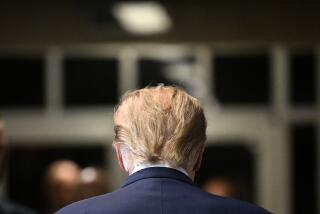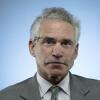In second presidential debate, style is likely to trump facts
President Obama misstated the rising rate of healthcare costs. Vice President Joe Biden mischaracterized the drawdown of troops in Afghanistan. Mitt Romney overstated the number of jobless Americans, a figure his running mate, Paul D. Ryan, repeated.
None of those misleading statements in the last two debates was as important, however, as the way they were delivered: by a slumberous Obama, an energetic Biden, an authoritative Romney and an earnest if sometimes ruffled Ryan.
When Obama and Romney meet on New York’s Long Island on Tuesday night for their second matchup, this one a town-hall-style debate, legions of experts will be ready to pounce on their every utterance, calling out exaggerations and citing obvious omissions. The candidates, positioned a few feet apart, will stand ready to fact-check each other, as they see fit.
PHOTOS: Memorable debate moments
But the typical voter, especially an undecided one, may be less attuned to the bullet-point intricacy of policy proposals than the candidates’ body language and demeanor, as well as the nonverbal cues sent as they share a stage for one of the few times in the lengthy campaign.
It is not that the facts don’t matter. A serious blunder, like President Ford’s misstatement in 1976 regarding the Soviet sway over Eastern Europe, can damage a candidate by raising doubts about his mastery of a subject and, more, his overall competence.
And yet presented a barrage of information, much of it complicated, and possessing an inherent skepticism toward anything politicians say, much of it well-placed, debate-watchers often seek other means of taking a candidate’s measure.
“If you have a five-point plan you mention in the first few minutes, for many voters that’s all the detail they need,” said Floyd Ciruli, a veteran pollster in Colorado, one of this year’s hardest-fought battleground states. “Most people, who are less than policy wonks, less than highly partisan, single-issue voters, are more attuned to a strong theme, a feel, a gut-level reaction, a tone, a style.”
Indeed, the memories that tend to linger in debate history — Michael S. Dukakis’ clinical detachment, President George H.W. Bush’s impatient glance at his watch, Al Gore’s theatrical sighing — are entirely stylistic. (The issues — taxes, the economy, appointments to the Supreme Court, a strong defense — are similar every four years.) Witnessing those unscripted, even unconscious, moments, voters often find clues to the heart beating beneath the polished political veneer.
“People are hiring a leader, not a scientific expert ... or a wonk or know-it-all,” said Samuel Popkin, a UC San Diego political scientist and occasional Democratic campaign consultant, who has written a book, “The Candidate,” about winning and holding the White House. “They’re looking for trustworthiness, a person who will think of them when it matters.”
Central issues of Election 2012
Voters see debates as a unique opportunity to make that assessment, said Brett O’Donnell, a leading Republican debate coach, viewing the head-to-head matchups as “a chance to see the candidates stripped of the regalia of their campaigns ... to think on their feet and face a trial by fire.”
The impression voters take away, O’Donnell said, may come chiefly from how the candidates behave: their vocal inflections, facial expressions and other ways they communicate that have nothing to do with policy positions. “Most individuals are extremely oriented to visual learning and put a lot of stock in those cues,” O’Donnell said.
For many voters, debates simply reinforce preconceived notions. That is especially true for partisans and those whose minds are firmly made up, which explains why many Democrats found Biden’s boisterous debate performance last week compelling (and even appropriate, given their dim view of Wisconsin Rep. Ryan) and Republicans found the vice president’s smirking and eye-rolling so off-putting.
Even Obama’s widely panned first debate outing only moved the polls a bit — though, given the closeness of the race, that was enough to alter the contest’s momentum. There has been no huge defection of Democrats to Romney, whose uptick in polls has resulted largely from a firming up of Republican support and gains among some independents.
Those who have followed the campaign even somewhat closely learned little from the first two debates that they didn’t know already. Obama wants to raise taxes on the wealthiest Americans, protect his sweeping healthcare bill passed in 2010 and says his policies — including bailing out the auto industry — have produced a steady, if frustratingly slow, economic recovery.
Romney opposes the tax hikes for the wealthy, wants to repeal “Obamacare,” as he calls it, and says the president squandered billions of taxpayers’ dollars on programs that did nothing to help the economy while exploding the national debt.
Neither offered much of a vision for the next four years.
But the Brookings Institution’s Darrell West said the way the candidates behave may be more important to undecided voters and to those still open to changing their minds. “They’ve seen the policy statements and heard the claims, and none of that has persuaded them to commit,” said West, a political communications expert. “These individuals focus more on intangibles and often take cues about the candidates from how they act.”
The town hall format Tuesday presents both Obama and Romney with challenges beyond the substance of what each has to say. Each must connect with individual questioners while speaking to the tens of millions of voters watching at home. Each must engage the other — which seems of particular import for Obama, given the way he appeared to shrink from Romney two weeks ago — without ignoring the studio audience or treating people as mere props.
And there are practical questions — should a candidate wander the stage, sit or stand while their opponent is speaking? — that may seem trivial but can leave a strong impression for voters who are, literally, watching every move.
Tad Devine, a longtime Democratic strategist who has taken part in countless debate rehearsals, suggested a command of facts and holstering a snappy comeback line is only part of the preparation.
“Every moment of the debate they’re communicating. That’s really the big lesson,” Devine said. “Even when their opponent is speaking, they may communicate disagreement by shaking their head, they may communicate exasperation, as the vice president did several times the other night.... All of that matters, and you want to make sure a candidate understands that before they go into these things.”
POLITICAL CARTOONS: Horsey’s Top of the Ticket
More to Read
Get the L.A. Times Politics newsletter
Deeply reported insights into legislation, politics and policy from Sacramento, Washington and beyond. In your inbox three times per week.
You may occasionally receive promotional content from the Los Angeles Times.







